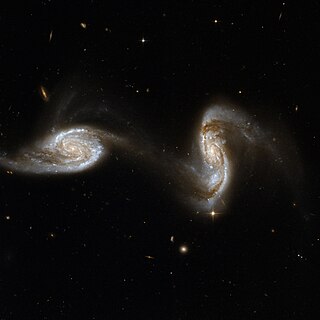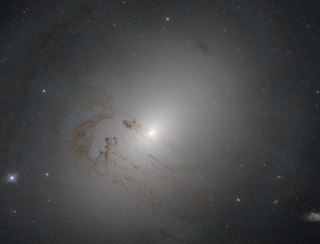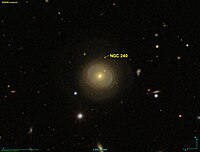
NGC 381 is an open cluster of stars in the northern constellation of Cassiopeia, located at a distance of approximately 3,120 light-years from the Sun. Credit for the discovery of this cluster was given to Caroline Herschel by her brother William in 1787, although she may never have actually seen it.

Arp 240 is a pair of interacting spiral galaxys located in the constellation Virgo. The two galaxies are listed together as Arp 240 in the Atlas of Peculiar Galaxies. The galaxy on the right is known as NGC 5257, while the galaxy on the left is known as NGC 5258. Both galaxies are distorted by the gravitational interaction, and both are connected by a tidal bridge, as can be seen in images of these galaxies.

In astronomy, the Collinder catalogue is a catalogue of 471 open clusters by Swedish astronomer Per Collinder. It was published in 1931 as an appendix to Collinder's paper On structural properties of open galactic clusters and their spatial distribution. Catalogue objects are denoted by Collinder, e.g. "Collinder 399". Dated prefixes include as Col + catalogue number, or Cr + catalogue number, e.g. "Cr 399".

NGC 105 is a spiral galaxy estimated to be about 240 million light-years away in the constellation of Pisces. It was discovered by Édouard Stephan in 1884 and its apparent magnitude is 14.1.

NGC 109 is a spiral galaxy estimated to be about 240 million light-years away in the constellation of Andromeda. It was discovered by Heinrich d'Arrest in 1861 and its magnitude is 13.7.

NGC 2655 is a lenticular galaxy in the constellation Camelopardalis. It is at a distance of 60 million light years from Earth. NGC 2655 is a Seyfert galaxy. The galaxy has asymmetric dust lanes in the centre of the galaxy, tidal arms and extended neutral hydrogen gas and may have recently experienced a merger. The complex dynamics of the HI and optical tails suggest the galaxy may have undergonen more mergers in the past. A weak bar has been detected in infrared H band. The diameter of the disk of the galaxy is estimated to be 60 Kpc.

NGC 233 is an elliptical galaxy located in the constellation Andromeda. It was discovered on September 11, 1784 by William Herschel.

NGC 274 is a lenticular galaxy in the constellation Cetus. It is a pair of galaxies, the other being NGC 275, which it is currently interacting with. It was discovered on September 10, 1785 by William Herschel. It is roughly 120 million light-years away.

NGC 293 is a barred spiral galaxy in the constellation Cetus. It was discovered on September 27, 1864 by Albert Marth.

NGC 327 is a spiral galaxy in the constellation Cetus. It was discovered on September 27, 1864 by Albert Marth. It is described by Dreyer as "faint, small, extended." It is nearby galaxies NGC 329, NGC 325 and NGC 321.

NGC 364 is a barred lenticular galaxy in the constellation Cetus. It was discovered on September 2, 1864 by Albert Marth. It was described by Dreyer as "very faint, very small."

NGC 375 is an elliptical galaxy located in the constellation Pisces. It was discovered on September 12, 1784 by William Herschel. It was described by Dreyer as "pretty faint, small, round, brighter middle." Along with galaxies NGC 379, NGC 380, NGC 382, NGC 383, NGC 384, NGC 385, NGC 386, NGC 387 and NGC 388, NGC 375 forms a galaxy cluster called Arp 331.

NGC 5559 is a barred spiral galaxy, located 240 million light-years away in the constellation of Boötes. It was discovered on April 10, 1785 by the astronomer William Herschel.

NGC 479 is a spiral galaxy in the constellation Pisces. It was discovered by German astronomer Albert Marth on October 27, 1864. It is about 240 million light-years away from Earth.

NGC 519, also occasionally referred to as PGC 5182 is an elliptical galaxy located approximately 242 million light-years from the Solar System in the constellation Cetus. It was discovered on 20 November 1886 by astronomer Lewis Swift.

NGC 703 is a lenticular galaxy located 240 million light-years away in the constellation Andromeda. The galaxy was discovered by astronomer William Herschel on September 21, 1786 and is also a member of Abell 262.

NGC 705 is a lenticular galaxy located 240 million light-years away in the constellation Andromeda. The galaxy was discovered by astronomer William Herschel on September 21, 1786 and is also a member of Abell 262.
NGC 7196 is an elliptical galaxy registered in the New General Catalogue. It is located in the direction of the Indus constellation, at a distance of circa 150 million light years. It was discovered by the English astronomer John Herschel in 1834 using a 47.5 cm reflector.

NGC 765 is an intermediate spiral galaxy located in the constellation Aries. It is located at a distance of circa 220 million light years from Earth, which, given its apparent dimensions, means that NGC 765 is about 195,000 light years across. It was discovered by Albert Marth on October 8, 1864. The galaxy has an extensive hydrogen (HI) disk with low surface brightness, whose diameter is estimated to be 240 kpc.

NGC 3902 is an intermediate spiral galaxy in the constellation Leo. It was discovered on April 6th, 1785 by William Herschel and observed on February 19th, 1827 by John Herschel. It is estimated to be 180 to 185 million light-years away, and its redshift-independent distance estimates to about 185 to 240 million light-years. It is around 75 thousand light-years in diameter.



















